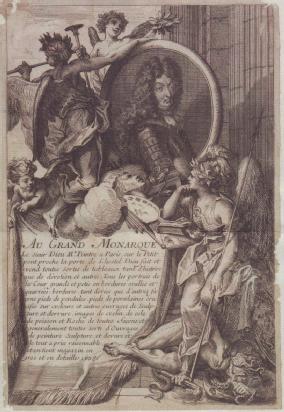Selling Consumption in the Eighteenth Century: Advertising and the Trade Card
| Advertising has long been known to be both the reflection of and means to create desire for commodities. The study of historical advertising is, therefore, a key means to understand consumers and consumer markets in early modern society. Despite an extensive literature on the proliferation of new goods and their consumers between 1760 and 1800, there has been little research on the part played by advertising in creating consumer markets. Furthermore, research has tended to focus on texts and the English speaking world. Waddesdon Manor has a unique collection of French and German trade cards dating from the seventeenth and eighteenth centuries. Trade cards, prints with a combination of image and text, provided information about the location, goods and services of a given business. A thorough study of these objects can inform us about early modern attitudes to the burgeoning world of goods and the inter-relationship between commercial and fine art. ‘Selling Consumption,’ is a three-year Leverhulme funded project that seeks to catalogue and analyse these cards using approaches from social history, material culture, art history and the history of collections to provide a resource based on this rich, but under-studied, form of commercial ephemera. The catalogue will be published in the form of an on-line database in Spring 2009, providing scholars with a vital resource to continue the study and understanding of this material. The database has been designed to allow scholars to search by trade or product as well as by decorative motif or iconographic subject. A further field entitled ‘Research Concepts’ aims to facilitate searching the database through the lens of contemporary research interests. |
© The National Trust, Waddesdon Manor |
Marvels in the Marketplace: the Germanic trade cards at Waddesdon Manor
In the course of digitising, cataloguing and investigating the rare collection of trade cards at Waddesdon Manor, the uniqueness of a particular part of the collection has come to light. The last of the four volumes does not contain French prints, nor is it arranged in the broad chronology used to organise the rest of the material. A group of cards relating to hotels and inns, as well as a significant number representing dealers in paintings, antiquities and silverware, provides evidence of links between French mercantile travel and the formation of the collection. Another group of cards illustrating human prodigies and fair-ground entertainers indicates that this 'French' view of Germanic cultural activity was figured through the spectacle of abnormal bodies. Currently, it is believed that the French collections of ephemera were driven by nostalgia for the Paris of the Ancien Regime. These cards indicate that other interests helped to shape the collection. A three month British Academy grant will allow the cataloguing of this volume using the methodologies developed in the ‘Selling Consumption’ project, as well as allowing discreet research to be carried out on these cards.
In 2009, Waddeson: The Rothschild Collection , went live. This is an online database of the Waddeson Manor trade card collection. The database has been designed to allow scholars to search by trade or product as well as by decorative motif or iconographic subject.
, went live. This is an online database of the Waddeson Manor trade card collection. The database has been designed to allow scholars to search by trade or product as well as by decorative motif or iconographic subject.
Katie Scott, ‘The Waddesdon Trade Cards: More than One history', Journal of Design History, 17 (2004): 91-100.
Maxine Berg and Helen Clifford, ‘Selling Consumption in the Eighteenth Century: Advertising and Promotional Culture’, paper presented at ‘Knowing Consumers: Actors, Images, Identities in Modern History’, Zentrum für Interdisziplinäre Forschung in Bielefeld, Germany, February, 2004.
Alicia Weisberg-Roberts, ‘Ces fragiles et périssables monuments de la vie privée d’une époque:’Destailleur, the Rothschilds and the Waddesdon Trade Card Collection’, paper presented at ‘Waddesdon/Warwick Trade Card Study Day’, Waddesdon Manor, June 2006.
Phillippa Plock, ‘The Waddesdon-Warwick Trade Card Project: Aims and Themes’, paper presented at ‘The Trade Card: A Colloquium’, Centre for Ephemera Studies, Department of Typography & Graphic Communication, The University of Reading, November 2006.
Maxine Berg and Helen Clifford, ‘Selling Consumption in the Eighteenth Century: Advertising and the Trade Card in Britain and France’, Cultural & Social History, 4 (2007), 145-170.
Phillippa Plock, ‘Art Becomes Artisan: The Case of Selling Antoine Dieu’, paper presented at the 33rd Conference of the Association of Art Historians, ‘Contestations’, University of Ulster, Belfast, April 2007.
(Forthcoming) Phillippa Plock, ‘Art, advertising and the Académie: the visual tension of Parisian artists’ trade cards’, paper to be presented at the University of Leeds, Eighteenth-century Group, March 2008
Philippa Hubbard, ‘Eighteenth Century Advertising: The trade card in Britain and America’, 2009 PhD dissertation, University of Warwick.

